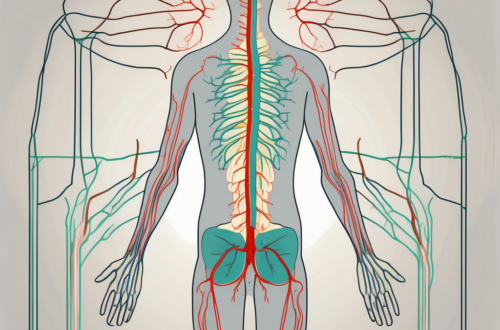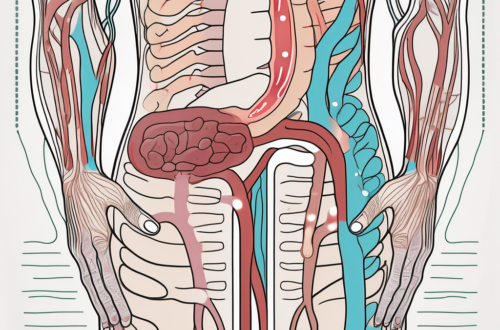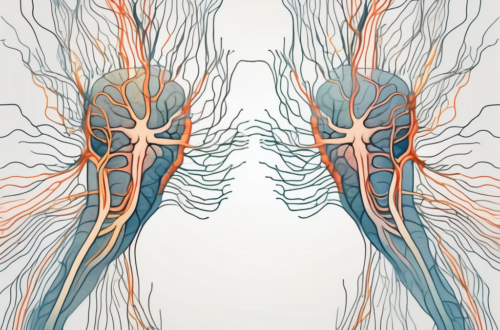The nervous system plays an integral role in regulating various bodily functions. Among these functions is the positive inotropic effect, which influences heart function. However, there is often confusion regarding whether this effect is controlled by the parasympathetic or sympathetic nervous system. To understand this complex relationship, it is essential to delve into the intricacies of the nervous system and its involvement in the positive inotropic effect.
Understanding the Nervous System
The nervous system is a sophisticated network of nerves and cells that transmit signals throughout the body. It is divided into two main branches: the central nervous system (CNS) and the peripheral nervous system (PNS). The CNS consists of the brain and spinal cord, while the PNS encompasses the nerves that extend beyond these structures. The PNS is further divided into the autonomic nervous system (ANS) and the somatic nervous system.
The ANS is responsible for regulating involuntary bodily functions, including heart rate, blood pressure, and digestion. It comprises two divisions: the parasympathetic nervous system and the sympathetic nervous system, each harboring their distinct roles and mechanisms.
The Role of the Parasympathetic Nervous System
The parasympathetic nervous system, often referred to as the “rest and digest” system, primarily functions to conserve and restore energy. When activated, this system slows down heart rate, constricts blood vessels, and stimulates digestion. It emanates from cranial nerves and the sacral region of the spinal cord, with the main neurotransmitter involved being Acetylcholine (ACh).
Contrary to popular belief, the parasympathetic nervous system does not typically elicit a positive inotropic effect. Instead, it exerts a negative inotropic effect, which decreases the force of heart contractions. This response is vital in achieving a balanced cardiovascular system and maintaining homeostasis in the body.
Furthermore, the parasympathetic nervous system plays a crucial role in promoting relaxation and reducing stress. When activated, it helps to lower blood pressure, decrease respiratory rate, and enhance digestion. This allows the body to conserve energy and focus on essential functions such as tissue repair and growth.
The Function of the Sympathetic Nervous System
In contrast to the parasympathetic nervous system, the sympathetic nervous system is responsible for the “fight or flight” response, preparing the body for action-packed situations. It enhances heart rate, dilates blood vessels, and diverts blood flow to essential organs. The sympathetic nervous system operates through the release of norepinephrine, which binds to adrenergic receptors on heart cells.
Under certain circumstances, the sympathetic nervous system can elicit a positive inotropic effect. This effect increases the contractility of the heart, leading to more robust contractions and enhanced pumping of blood. By increasing cardiac output, the sympathetic nervous system aids in supplying oxygen and nutrients to all parts of the body during heightened activity or stress.
In addition to its role in the “fight or flight” response, the sympathetic nervous system also plays a vital role in regulating body temperature. When the body is exposed to cold temperatures, the sympathetic nervous system triggers vasoconstriction, reducing blood flow to the skin and conserving heat. Conversely, in hot temperatures, it promotes vasodilation, allowing for increased blood flow to the skin and facilitating heat dissipation.
Moreover, the sympathetic nervous system influences various other physiological processes, such as pupil dilation, bronchodilation, and the release of glucose from the liver. These responses collectively prepare the body for quick and efficient responses to potentially dangerous or challenging situations.
Defining Positive Inotropic Effect
Positive inotropic effect refers to the increased force or strength of cardiac muscle contractions, leading to improved pumping efficiency. It is crucial for maintaining adequate blood circulation throughout the body and delivering oxygen and nutrients to various tissues and organs.
The positive inotropic effect is a fascinating physiological phenomenon that plays a significant role in the cardiovascular system. Let’s delve deeper into its impact on heart function and the factors that influence it.
The Impact on Heart Function
The positive inotropic effect has a direct impact on heart function. By increasing the force of contractions, it enhances stroke volume, which is the amount of blood ejected by the heart with each beat. Consequently, this leads to an increased cardiac output, ensuring an efficient supply of oxygen-rich blood to tissues and organs.
Imagine your heart as a powerful pump, tirelessly working to circulate blood throughout your body. The positive inotropic effect acts as a booster, enabling your heart to pump blood with more force and efficiency. This increased pumping power ensures that every part of your body receives the vital oxygen and nutrients it needs to function optimally.
However, it is crucial to note that an excessive positive inotropic effect can be detrimental. For individuals with preexisting heart conditions, such as heart failure or arrhythmias, an exaggerated increase in contractility may worsen their condition, leading to adverse effects. Therefore, it is essential to consult with a healthcare professional before considering any interventions that may modify the inotropic effect.
Factors Influencing Positive Inotropic Effect
Several factors influence the positive inotropic effect. One notable factor is the concentration of calcium ions within cardiac cells. Calcium ions play a vital role in regulating muscle contraction, and an increase in intracellular calcium can intensify the strength of contractions, resulting in a positive inotropic effect.
Think of calcium ions as the key that unlocks the door to stronger contractions. When the concentration of calcium ions within cardiac cells increases, it signals the heart muscle to contract more forcefully, leading to a heightened positive inotropic effect. This intricate interplay between calcium ions and cardiac muscle contraction showcases the remarkable complexity of the human body.
Additionally, various medications and substances can influence the heart’s contractility. For example, certain positive inotropic medications, such as digitalis glycosides, may be prescribed to individuals with heart failure to enhance cardiac output. These medications work by modulating the concentration of calcium ions within cardiac cells, thereby increasing contractility. However, the administration of these medications should only occur under the supervision of a healthcare professional, as they can have potent effects on the cardiovascular system.
Understanding the factors that influence the positive inotropic effect allows healthcare professionals to tailor treatment strategies to individual patients’ needs. By harnessing the power of these factors, medical interventions can be designed to optimize cardiac function and improve overall patient outcomes.
The Connection Between Inotropic Effect and Nervous System
The relationship between the positive inotropic effect and the nervous system is intricate and fascinating. It is a complex interplay between the sympathetic and parasympathetic nervous systems, both of which play crucial roles in maintaining heart function and overall homeostasis.
Let’s delve deeper into the influence of each system on the inotropic effect:
Parasympathetic Nerve’s Influence on Inotropic Effect
The parasympathetic nervous system primarily acts as a counterbalance to the sympathetic nervous system. While it does not typically elicit a positive inotropic effect, it indirectly influences heart function in a remarkable way.
One of the parasympathetic nervous system’s main actions is to reduce heart rate. By slowing down heart rate, the parasympathetic nervous system allows the heart more time to fill with blood during diastole, the relaxation phase of the cardiac cycle. This increased filling time leads to increased preload, which is the amount of blood in the ventricles before contraction. And as we know, increased preload results in enhanced contractility.
This effect is commonly known as the Frank-Starling mechanism, named after the physiologists Otto Frank and Ernest Starling, who discovered it. It is a fascinating mechanism that allows the heart to adapt to varying demands by adjusting its contractile force based on the amount of blood it receives during diastole.
Sympathetic Nerve’s Role in Inotropic Effect
In contrast to the parasympathetic nervous system, the sympathetic nervous system has a more direct impact on the positive inotropic effect. It is responsible for the famous “fight or flight” response, which prepares the body for intense physical activity or stressful situations.
When the sympathetic nervous system is activated, it stimulates the release of norepinephrine, a neurotransmitter that binds to adrenergic receptors on cardiac cells. This binding triggers a cascade of events that ultimately leads to an increase in intracellular calcium levels within the cardiac cells.
Why is increased intracellular calcium important for the inotropic effect? Well, calcium is a key player in the contraction of cardiac muscle. When calcium levels rise, it binds to specific proteins within the muscle cells, initiating a series of molecular events that result in stronger and more forceful contractions.
So, the sympathetic nervous system, through the release of norepinephrine and subsequent increase in intracellular calcium levels, directly enhances the contractility of the heart. This positive inotropic effect allows the heart to pump blood more efficiently, ensuring an adequate supply of oxygen and nutrients to the body’s tissues during times of increased demand.
Understanding the intricate relationship between the nervous system and the inotropic effect is crucial for comprehending the complex mechanisms that regulate heart function. Both the parasympathetic and sympathetic nervous systems work in harmony to maintain the delicate balance required for optimal cardiac performance and overall well-being.
Debunking Common Misconceptions
There are several misconceptions surrounding the roles of the parasympathetic and sympathetic nervous systems in the positive inotropic effect. Clarifying these misconceptions is essential to gain a comprehensive understanding of the topic at hand.
Clarifying the Parasympathetic and Sympathetic Nerve Confusion
It is often mistakenly assumed that the parasympathetic nervous system solely elicits a positive inotropic effect due to its role in reducing heart rate. However, as discussed earlier, the parasympathetic nervous system primarily exerts a negative inotropic effect. This misconception can be attributed to the indirect influence of the parasympathetic nervous system on enhancing contractility through the Frank-Starling mechanism.
The Frank-Starling mechanism, also known as the Starling’s law of the heart, describes the relationship between the initial length of cardiac muscle fibers and the force of contraction. When the parasympathetic nervous system slows down the heart rate, it allows more time for ventricular filling, resulting in increased preload. This increased preload stretches the cardiac muscle fibers, leading to a more forceful contraction during systole. Therefore, while the parasympathetic nervous system does not directly cause a positive inotropic effect, its influence on preload indirectly enhances contractility.
Additionally, it is important to note that the sympathetic nervous system plays a significant role in the positive inotropic effect. The sympathetic fibers release norepinephrine, which binds to beta-adrenergic receptors on cardiac muscle cells. This binding activates a signaling cascade that ultimately leads to increased intracellular calcium levels, enhancing contractility. The sympathetic nervous system also increases heart rate, which further contributes to cardiac output.
Correcting Misunderstandings About Positive Inotropic Effect
Another common misunderstanding is that a positive inotropic effect is inherently beneficial in all circumstances. While it is crucial for maintaining adequate cardiac output, an exaggerated positive inotropic effect can lead to adverse effects, especially in individuals with underlying heart conditions. It is essential to achieve a balance in cardiac contractility to ensure optimal heart function.
Excessive sympathetic stimulation or the use of positive inotropic medications can lead to increased myocardial oxygen demand, which may be detrimental in patients with limited coronary blood flow. This can result in myocardial ischemia, arrhythmias, or even myocardial infarction. Therefore, healthcare professionals carefully evaluate the risks and benefits of interventions that enhance contractility, taking into consideration the individual patient’s cardiovascular health.
If you have concerns or questions about the positive inotropic effect and how it may impact your health, it is advised to consult with a healthcare professional. They can provide personalized guidance based on your specific medical history and help you make informed decisions regarding any potential interventions.
Future Research Directions
Although the connection between the positive inotropic effect and the parasympathetic and sympathetic nervous systems is relatively well-established, there is still room for further exploration. Continued research in this field may shed light on new insights and lead to better therapeutic strategies for individuals with cardiovascular conditions.
Potential Studies on Parasympathetic and Sympathetic Nerves
Future studies could focus on unraveling the specific mechanisms by which the parasympathetic nervous system influences the positive inotropic effect. Exploring the indirect pathways and elucidating the contributions of neurotransmitters and receptor subtypes could provide a more comprehensive understanding of the parasympathetic control of cardiac contractility.
One potential avenue of research could involve investigating the role of acetylcholine, a key neurotransmitter released by the parasympathetic nerves, in modulating the positive inotropic effect. By studying the effects of acetylcholine on specific receptor subtypes, researchers may gain insights into the precise signaling pathways involved in enhancing cardiac contractility.
Furthermore, exploring the interplay between the parasympathetic and sympathetic nervous systems in regulating the positive inotropic effect could be an intriguing area of investigation. By examining how these two branches of the autonomic nervous system interact and influence each other’s effects on cardiac contractility, researchers may uncover novel therapeutic targets for cardiovascular conditions.
Exploring the Inotropic Effect Further
Additionally, more research is warranted to investigate the intricate relationship between the positive inotropic effect and the sympathetic nervous system. Further elucidation of the downstream signaling pathways, the involvement of other neurotransmitters, and potential therapeutic targets may pave the way for novel interventions aimed at modulating cardiac contractility.
One potential research direction could involve studying the role of norepinephrine, a key neurotransmitter released by the sympathetic nerves, in mediating the positive inotropic effect. By examining the specific receptor subtypes activated by norepinephrine and their downstream signaling cascades, researchers may gain a deeper understanding of the molecular mechanisms underlying the enhancement of cardiac contractility.
Moreover, investigating the potential crosstalk between the sympathetic nervous system and other signaling pathways involved in cardiac contractility could be a fruitful area of exploration. By examining how factors such as hormones, cytokines, and growth factors interact with the sympathetic system to modulate the positive inotropic effect, researchers may uncover new therapeutic avenues for cardiovascular diseases.
In Conclusion
The positive inotropic effect is a complex phenomenon influenced by multiple factors, including the nervous system. While the parasympathetic nervous system primarily exerts a negative inotropic effect, the sympathetic nervous system can elicit a positive inotropic effect, enhancing cardiac contractility. Debunking common misconceptions and highlighting the need for a balanced inotropic response is crucial for understanding the impact on heart function. Further research is essential to uncover the intricacies of this relationship and improve therapeutic approaches for individuals with cardiovascular conditions.





